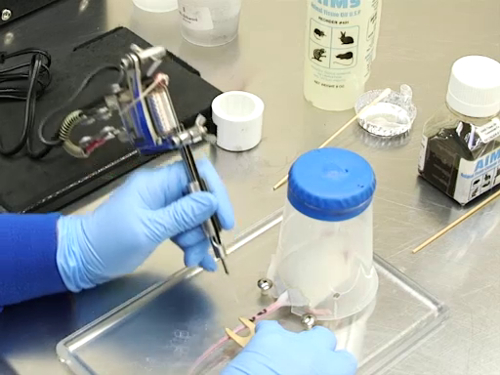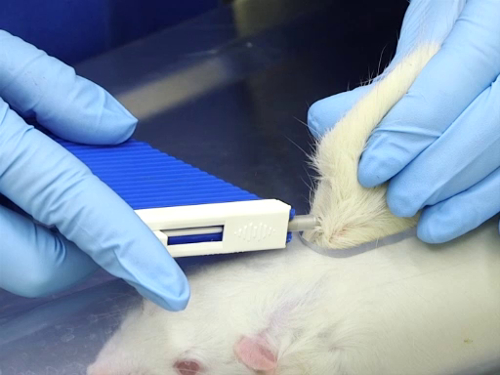啮齿动物鉴定 (2)
Overview
来源: 凯斯图尔特, RVT, RLATG, CMAR;瓦莱丽. 施罗德, RVT, RLATG。圣母大学, 在
动物记录必须得到准确的维护, 以确保数据收集是正确的。记录的范围从保持笼卡的信息, 以拥有一个详细的数据库与所有有关的信息, 每个动物。记录记录的主要组成部分是研究动物的个体识别。有多种方法可用于鉴别小鼠和大鼠。本视频描述了纹身、微芯片放置和临时识别方法的程序技术, 并探讨了每个步骤的优点.
Procedure
1. 尾部纹身
尾部纹身很容易阅读, 不需要处理动物.

图1。成年老鼠的尾巴纹身
- 根据制造商和 #39 的说明准备纹身设备。少量墨水是必需的。黑染料应用于白化小鼠或大鼠, 绿色染料的色素小鼠或大鼠.
- 为识别准备动物.
注意: 为了尽量减少忧虑或苦恼, 应在手术室而不是在动物居住区进行尾部纹身。- 适当地限制动物进行纹身, 以使运动最小.
- 断奶大鼠使用塑料缺口杯进行克制, 在纹身平台上的螺栓下固定杯子的唇, 并通过缺口延伸到尾部.
- 成年小鼠可以通过一杯抑制剂来克制, 尾巴从开口处拉紧, 杯子的法兰通过平台或其他装置举行.
Application and Summary
References
- Robinson, V., Morton, D.B., Anderson, D., Carver, J.F.A., Francis, R.J., Hubrecht, R., Jenkins, E., Mathers, K.E., Raymond, R., Rosewell, I., Wallace, J., and Wells, D.J. 2003. Refinement and reduction in production of genetically modified mice. Laboratory Animals. 37:S1-S50.
- Schaefer, D.C., Asner, I.N., Seifert, B., Bürki, K., and Cinelli, P. 2010. Analysis of physiological and behavioural parameters in mice after toe clipping as newborns. Laboratory Animals. 44:7-13
- Castelhano-Carlos, M.J., Sousa, N., Ohl, F., and Baumans, V. 2010. Identification methods in newborn C57BL/6 mice: a developmental and behavioural evaluation. Laboratory Animals. 44: 88-103.
- Danneman, P.J., Suckow, M.A., and Brayton, C.F. 2013. The laboratory mouse. Second edition. New York, NY: CRC Press.
- Institute for the Laboratory Animal Research. 2011. Guide for the care and use of laboratory animals, 8th ed. Washington (DC): National Academies Press.
跳至...
此集合中的视频:

Now Playing
啮齿动物鉴定 (2)
Lab Animal Research
25.6K Views

啮齿动物的处理和克制技术
Lab Animal Research
174.4K Views

基本护理程序
Lab Animal Research
28.0K Views

育种和断奶的基本原理
Lab Animal Research
35.7K Views

啮齿动物识别 I
Lab Animal Research
54.7K Views

药物注射 I
Lab Animal Research
100.5K Views

药物注射 II
Lab Animal Research
34.9K Views

药物注射 III
Lab Animal Research
31.4K Views

药物注射 IV
Lab Animal Research
51.6K Views

血液采集 I
Lab Animal Research
171.6K Views

血液采集 II
Lab Animal Research
73.2K Views

麻醉诱导与维护
Lab Animal Research
50.4K Views

啮齿动物手术的考虑事项
Lab Animal Research
22.5K Views

诊断尸检和组织采集
Lab Animal Research
58.1K Views

无菌组织采集
Lab Animal Research
34.8K Views
版权所属 © 2025 MyJoVE 公司版权所有,本公司不涉及任何医疗业务和医疗服务。

